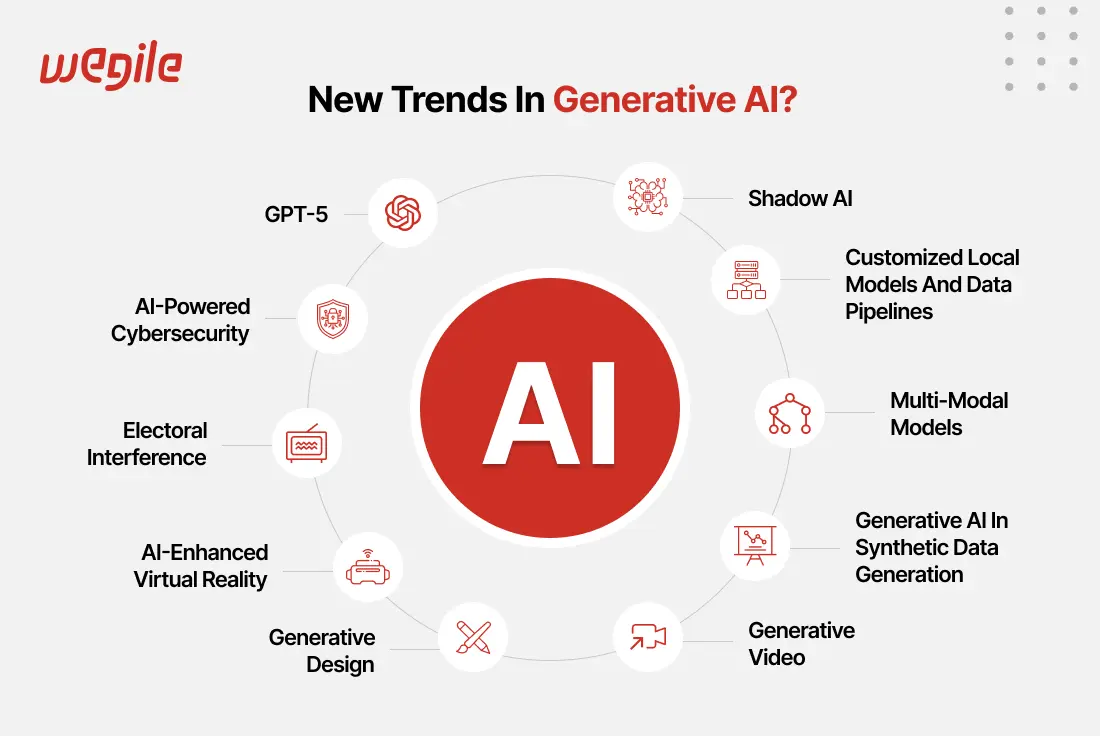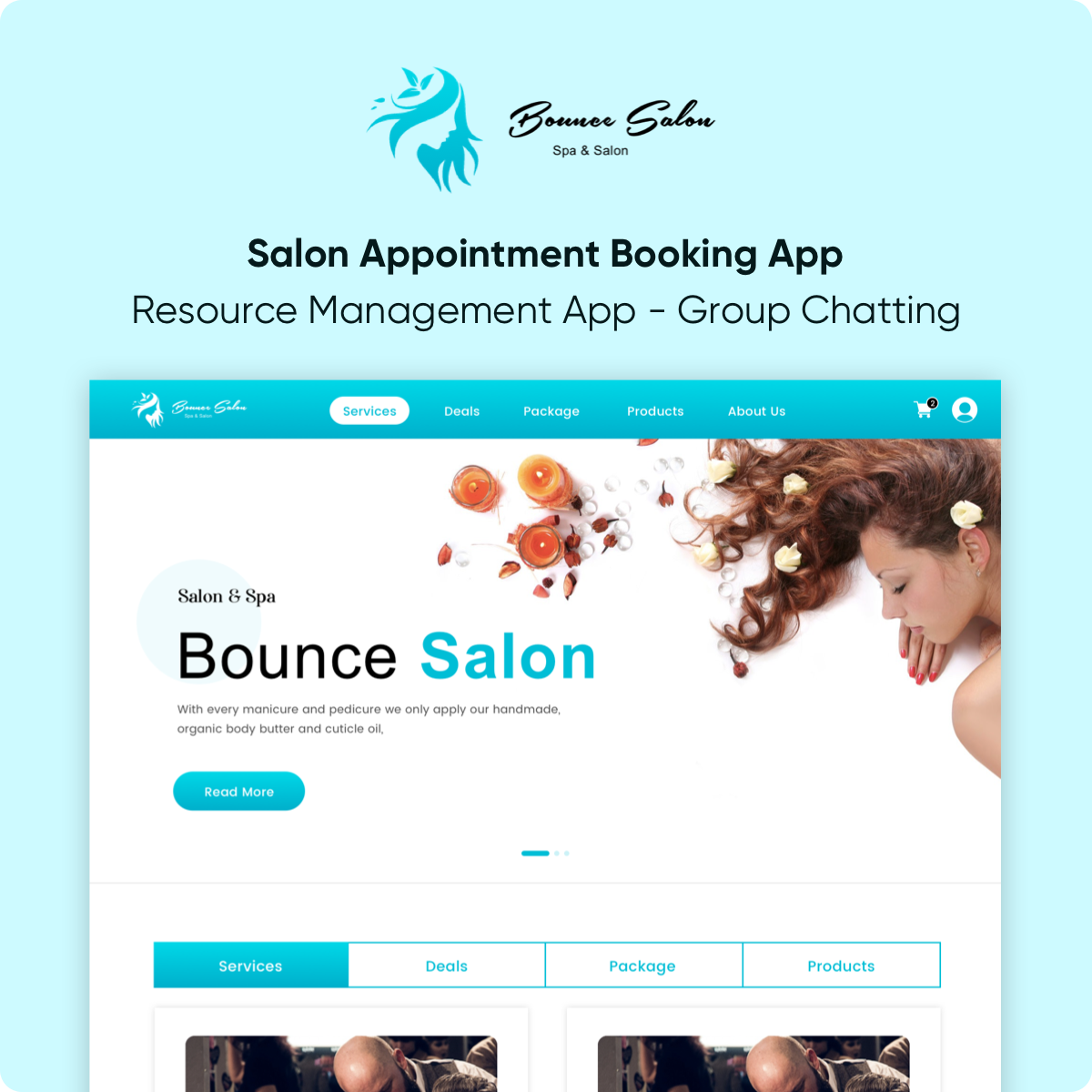Are you ready to jump into the thrilling world of generative AI solutions and uncover the cutting-edge advancements shaping our future? As we stand on the brink of 2024, the landscape of artificial intelligence is not just evolving, but it’s revolutionizing at an unprecedented pace. Did you know the latest models, like GPT-4, now operate with over a trillion parameters? What does this mean for the future of technology and our interaction with the digital world?
Imagine a world where AI can converse with you and predict and adapt to your preferences in real-time. From creating breathtaking artworks to generating predictive models that could foresee market trends, generative AI is no longer just a tool; it's becoming ubiquitous across multiple industries. But what's truly exciting about this technology as we approach 2024?
How can AI now assist in designing everything from your next favorite gadget to predicting the next big fashion trend? And what about its role in crucial sectors like healthcare, where AI-generated models propose new compounds for lifesaving drugs?
In this blog, we're exploring the latest advancements in generative AI, examining the exciting opportunities, ethical considerations, and challenges they present. Are you prepared to see how deep this rabbit hole goes? Join us to discover the exciting advancements in generative AI that everyone should know about today!

As the tech world buzzes with anticipation, the upcoming release of GPT-5 is a monumental milestone in the evolution of generative AI. Building on the colossal framework of GPT-4, which already boasts over a trillion parameters, GPT-5 is expected not just to step up the game but to redefine it entirely. But what does this mean in the world of artificial intelligence, and why should we keep our eyes peeled for its debut?
GPT-4 amazed us with its understanding and response capabilities, setting a new standard for what AI can achieve. Now, imagine an even more powerful model. Early whispers suggest that GPT-5 could dramatically expand on the number of parameters, diving deeper into the complexities of human language and interactions. But it's not just about size. The real magic lies in utilizing these parameters for more data, learning, and significantly more nuanced interactions.
The leap to GPT-5 isn't just adding more data; it requires incredible processing power. This power enables the AI to analyze and generate responses at speeds and accuracies we've never seen before. For tech enthusiasts and industry professionals, this means watching AI perform tasks in seconds that would take humans hours or even days. But how is such speed feasible? Thanks to advancements in computing infrastructure and optimization techniques that allow these massive models to operate efficiently without compromising on speed.
One of the standout features expected in GPT-5 is its enhanced accuracy and deeper contextual understanding. Where previous models might have faltered with ambiguity or complex sentence structures, GPT-5 aims to navigate these with unprecedented finesse. This isn't just about understanding words in a vacuum; it's about grasping nuances, cultural references, and even emotions, transforming how we interact with AI across various platforms, from customer service bots to personal assistants.
Generative AI finds diverse applications in the real world and the implications of GPT-5's capabilities are also going to be vast and varied across different sectors. In healthcare, imagine AI that can sift through medical research at lightning speeds to offer diagnosis support or treatment recommendations. In education, personalized learning assistants could adapt to each student's learning style, pace, and needs, revolutionizing educational accessibility and effectiveness.
In creative industries, the enhanced model could assist in scriptwriting, music composition, and game development. It offers tools that spark human creativity rather than replace it. In business, the applications range from advanced data analysis and decision-making support to creating dynamic and engaging marketing content that resonates with diverse audiences.
As we edge closer to the release of GPT-5, the excitement is palpable, not just for the technological advancements it promises but for the new horizons it opens up. This isn't just about a more powerful tool; it's about setting a new benchmark for what AI can achieve and how it can be integrated into our daily lives and work. In this era of rapid technological advancement, GPT-5 is more than a new model; it’s a forerunner of the future. It is signaling endless possibilities and inviting us to reimagine what we expect from technology. So, let's stay tuned, for the best is undoubtedly yet to come!
With cyber threats growing complex daily, the need for robust cybersecurity measures has never been more critical. Here comes generative AI, a game-changer in digital security, poised to revolutionize how we protect and defend our most sensitive data and systems. The convergence of AI with cybersecurity enhances existing protocols and creates new digital defense paradigms.
Generative AI is stepping into cybersecurity with capabilities that seem straight out of a sci-fi novel. Imagine a system that not only understands the tactics of cyber attackers but can also predict and counteract them before they inflict harm. Generative AI models are trained on vast datasets of security incidents and threat patterns, and are beginning to function as proactive defenders. They are constantly learning from new data and adapting to evolving threats.
One of the most potent capabilities of AI in cybersecurity is its ability to simulate sophisticated cyber attacks. These AI-driven simulations, often called "red teaming" exercises, involve the AI thinking like a hacker, identifying potential vulnerabilities in a system and attempting to exploit them. This is not about causing real damage but about testing the resilience of current security measures. By doing so, AI helps organizations identify weaknesses before they can be exploited maliciously.
Beyond just identifying threats, generative AI is also advancing its ability to automate responses to security breaches. When a potential threat is detected, AI systems can instantly generate defensive measures such as patching vulnerabilities, isolating affected systems, or even deploying countermeasures to neutralize ongoing attacks. This rapid response capability is crucial in a landscape where human response times can be the difference between a minor security breach and a catastrophic data loss.
What sets generative AI apart in cybersecurity is its capacity for continuous learning. Every attempted attack, whether successful or thwarted, becomes part of the learning matrix for the AI, enabling it to perform better in future encounters. This aspect of generative AI enhances its effectiveness and ensures that security systems evolve faster than threats, a crucial advantage in an ever-changing threat landscape.
Looking forward, the role of AI in cybersecurity is expected to expand significantly. We are moving towards a future where AI-powered systems will not only defend against attacks but also help draft laws, create ethical hacking guidelines, and set global standards for cybersecurity. The potential for AI to create a safer digital world is immense but not without challenges, especially concerning the ethical use and potential biases in AI models.
As we explore the complexities of cybersecurity in our connected world, integrating generative AI into our digital defenses offers exciting new possibilities. With its ability to simulate attacks, automatically respond to threats, and learn from each challenge, AI is quickly becoming more than just a tool; it's becoming a central part of our strategy for digital protection.
We are just starting to uncover what this technology can do, and the potential for enhancing security in both public and private sectors is enormous. Cybersecurity is no longer just about defending weak spots; it's about building a more innovative and more robust system with every challenge it faces.
As we move forward, let’s welcome the power of AI to not only react to threats but also to strengthen and adapt our digital defenses proactively. This journey is about resisting attacks and evolving with them to become more resilient than ever.
Have you ever imagined elections meeting AI? With generative AI, this isn't just a possibility; it's the newest trend and is happening right now.
One of the great benefits of AI in elections is through the personalization of campaigns. Political parties and candidates can use AI to analyze large amounts of voter data, such as their interests and past voting behavior. It allows them to tailor their messages to specific groups or even individual voters, making their communications more relevant and engaging. For example, if data shows that voters care deeply about environmental issues, AI can help craft messages or choose advertisements highlighting a candidate’s commitment to these issues.
AI can also help streamline and improve the efficiency of the electoral process. For example, AI can manage and analyze voter data, helping to ensure that voter rolls are up-to-date and people are registered properly. This can lead to smoother elections with fewer administrative problems.
However, the power of AI in elections isn’t without risks. One of the biggest concerns is the potential for spreading misinformation. AI can generate realistic-looking news articles, videos, and audio recordings that might mislead voters about candidates or issues. These tools can create fake content that looks very real, known as “deepfakes,” which can spread false information quickly and widely across social media and other platforms.
Another risk is using AI to micro-target voters with tailored messages to manipulate their opinions or discourage them from voting altogether. This can be particularly divisive, as it might exploit sensitive or controversial issues to stir up emotions and influence voter behavior.
As we progress, governments, tech companies, and watchdog groups must monitor how AI is used in elections. There needs to be a balance between harnessing AI for positive developments in the democratic process and preventing its misuse. Policies and regulations may need to be updated or created to govern the use of AI in political campaigns, especially concerning misinformation and voter manipulation.
While Generative AI holds fantastic potential to transform electoral processes by making campaigns more personalized and elections more efficient, careful oversight is also necessary to prevent misuse. Ensuring that elections remain fair and transparent in the AI age is beneficial and essential for maintaining trust in the democratic process.
Generative AI is starting to play a significant role in virtual reality (VR), making VR experiences even more exciting and authentic. This technology is helping create virtual worlds that are not just static backdrops but dynamic environments that can interact with you in real-time. Imagine putting on a VR headset and stepping into a world that changes based on what you say and do; that's the kind of immersive experience AI brings to VR.
One of the main ways AI enhances VR is by making the environments more realistic and interactive. AI can generate detailed, lifelike scenes that respond to your actions. For example, if you're in a VR game and you knock on a virtual door, AI can generate the sound of crashing and even have a character inside the game respond by opening the door. This makes the VR experience feel more like stepping into another world.
In the field of training and education, AI-enhanced VR is a game-changer. It's used to create realistic simulations for jobs requiring hands-on practice. For instance, medical students can use VR to practice surgeries in a risk-free environment. The AI part comes in by adjusting the difficulty of the procedure or responding to the student's actions with realistic outcomes. It means students can learn from their mistakes without any real-world consequences.
Virtual tours are another area where AI-enhanced VR is making a significant impact. Museums, historical sites, and even real estate agents can use Generative AI powered VR to allow people to explore places from their homes. AI makes these tours interactive; for example, if you're taking a virtual museum tour and spend a lot of time looking at a particular painting, AI can offer you more information about that artwork or show you similar pieces.
In entertainment, AI-enhanced VR creates more engaging games and interactive stories. In VR movies, for instance, the story could change based on where you look or how you react to characters. AI can control characters that adapt to your game style, making the game more challenging and fun.
As AI technology improves, the possibilities for AI-enhanced VR are almost limitless. We could see VR worlds that evolve, virtual characters that remember you and your preferences, or educational programs that adapt entirely to your learning speed and style.
Generative AI is making VR more than just a way to view excellent graphics; it's turning it into an interactive experience that can be used for learning, exploring, and having fun in ways we've only just begun to explore. The blend of AI and VR is changing how we see and interact with virtual worlds.
Generative design is an exciting way that AI is helping people create new things, from cars to buildings. This process uses AI to quickly generate many design options based on rules and goals set by a human designer. It's like having a super-powered brainstorming partner that can come up with hundreds of ideas in the time it takes you to draw one.
Imagine you're designing a new chair. You tell the AI what you need the chair to do (like hold a certain weight, be easy to stack, or use only a certain amount of material). The AI then uses these instructions to create many different designs. You can look through these and pick the best or combine elements from several designs. This way, AI helps you explore options you might not have thought of alone.
Generative design is excellent because it lets designers be more creative and get work done faster. Instead of starting from scratch every time, designers can use AI to generate many ideas and then refine the best ones quickly. It saves time and lets designers experiment with more daring, innovative ideas without wasting too much time or resources.
Companies like General Motors have used generative design to create new car parts in the automotive industry. For example, they used it to design a seat bracket that was not only stronger but also lighter than the usual kind. They started with a solid block in the AI software, set their requirements (like weight and strength), and let the AI propose different shapes. The final design looked unusual but met all their needs. It was made from a single piece instead of eight, simplifying manufacturing.
In architecture, generative design helps architects develop innovative building structures and layouts. A famous example is the work done on the Beijing National Stadium, where generative design was used to optimize the placement of steel beams. This made the structure strong and gave it a unique, eye-catching appearance that looked like a bird's nest, which matched the architect's vision and functional needs of the building.
As AI technology improves, generative design is expected to play a bigger role in many fields. We might see it used for cars and buildings and designing everyday items like clothing or furniture. It could make the design process more accessible to inexperienced designers, allowing more people to bring their ideas to life.
Generative design is a powerful tool that combines human creativity with AI's processing power to create better, more innovative products faster. It's already changing how we design everything from car parts to skyscrapers, and as AI continues to advance, its impact will only grow. This blend of AI and design is not just about making things different but improving them.
Generative video tools are transforming the way we create videos, making it easier and faster to produce content that looks professional. These tools use AI to help with various aspects of video production, from editing to adding special effects, which traditionally require a lot of skill and time. Even someone without a video editing background can quickly make high-quality videos.
These AI tools can automatically cut and edit footage, create realistic animations, and even generate human-like characters that can speak or act in videos. For example, if you're making a tutorial video, you can use these tools to add captions, highlight essential features, and clean up any mistakes in your footage, all with just a few clicks.
The big advantage of these tools is that they make professional-grade video production accessible to more people. Whether you're a small business owner, a teacher, or just someone with a story, you can now produce videos that look like a professional studio made them. This levels the playing field because you no longer need expensive equipment or software; you're good to go with a basic setup and generative video tools.
In media production and advertising, generative video tools are a game-changer. They allow companies to create more content in less time. They helps them keep up with the constant demand for new, engaging videos. This is especially important in today’s fast-paced world, where content quickly becomes outdated. Advertisers can also use these tools to personalize video ads for different audiences, making the ads more relevant and effective.
These tools are precious for personal content creators like YouTubers and social media influencers. They can help creators produce more content without sacrificing quality, which is crucial for building and maintaining an audience. Personal content creators can experiment with different styles and formats without needing extra help or spending lots of money, allowing them to express their creativity and stand out in a crowded space.
As these tools continue to improve, we'll likely see even more impressive features, like Generative AI, that can understand the context of a video and suggest edits or effects that match the mood or message. This could further simplify the video creation process and open new possibilities for customized content.
Generative video tools are not just making video production more accessible; they're changing who can produce videos and what those videos can look like. As these tools become more advanced and accessible, we can expect a surge in creative and diverse content, reshaping the media landscape, advertising, and personal expression. This is a thrilling time for anyone involved in video creation as the barriers to making great content continue to fall, paving the way for a new wave of innovation and creativity.
Generative AI is becoming quite influential in creating synthetic data, a type made from scratch by algorithms to simulate accurate data. This is particularly useful when actual data is hard to get, too sensitive to use, or might not represent everyone fairly. Synthetic data helps solve these problems by training other AI models without using real and personal data.
Generative AI uses patterns it learns from real data to create new data that looks similar but doesn't directly reflect any real individual's information. This process is like an artist who learns to paint portraits by studying many pictures of people and then starts creating completely new faces that don’t exist.
In industries like healthcare and finance, where privacy is crucial, synthetic data is precious. For example, in healthcare, AI needs vast amounts of data to learn how to diagnose diseases or predict patient outcomes. However, using real patient data raises concerns about privacy and security. Synthetic data allows researchers and developers to train AI models without exposing real patient data, ensuring people's health information stays private.
Similarly, companies in finance can use synthetic data to develop AI systems that detect fraud or manage risk without accessing customer data. This reduces the risk of sensitive financial information being leaked or misused.
While synthetic data is a powerful tool, it’s not perfect. The quality of the artificial data heavily depends on the quality of the real data used to create it. If the original data has errors or biases, these can also be reflected in the synthetic data. Therefore, it's crucial to ensure that the process of generating synthetic data is carefully managed and constantly improved.
As more industries recognize the benefits of synthetic data, its use is likely to grow. This will help advance AI technologies in sectors where data sensitivity is a high priority and promote more ethical use of data by ensuring privacy and reducing bias.
Generative AI in synthetic data generation offers a promising solution to data privacy challenges and availability in training AI systems. By providing a way to use valuable data without compromising individual privacy, synthetic data is set to play a crucial role in the development of more capable and trustworthy AI applications across various fields.
Multi-modal models in generative AI are exciting advancements that allow Generative AI to understand and use different types of information together, such as text, images, sounds, and even videos. This means AI can get a fuller picture of the world, much like humans do, by combining what it sees, hears, and reads.
In simpler terms, multi-modal models are like super-smart programs that can handle more than one data type at a time. For example, while earlier AI might only understand text, multi-modal AI can look at a picture, read the associated text, and listen to any sounds or speeches related to it all at once. This allows it to make better, more informed decisions and responses because it's not just relying on one type of information.
Tech giants like Google, Apple, and Microsoft are leading the way in pushing this technology forward. For example, Google’s AI can now understand videos by analyzing the images and sounds in them together rather than separately. This helps it understand the context better, like knowing that a scene in a movie is sad because of the sad music and the actors' expressions.
One of the most popular applications of multi-modal models is in virtual assistants like Siri and Alexa, which are now better at understanding commands involving different input types. For example, you could show a picture to Alexa and ask, "What’s in this photo?" and it would be able to tell you about it, thanks to multi-modal AI.
These models don't just make AI smarter; they also make interacting with AI more natural and intuitive for us. Since the AI can understand multiple types of information, you can interact with it more flexibly, using your voice and visuals, much like you would with another person.
Another area where multi-modal models are making a significant impact is in customer service. Companies use generative AI to provide better support by holistically understanding customer queries. For instance, when a customer sends a complaint through email with a picture attached, the AI can analyze both the text and the image to understand the problem better and provide a more accurate response.
The future of multi-modal models looks promising as they continue to evolve. We can expect even more interactive and immersive AI experiences, such as in education, where a learning app could respond to students through text, diagrams, and spoken explanations, all adapted to the student’s needs in real time.
Multi-modal generative AI represents a significant step in making machines understand the world more than humans do. By combining different types of data, AI can become more functional, versatile, and capable of handling complex tasks that involve seeing, hearing, and reading. This opens up new possibilities for using technology in our everyday lives, making our interactions with AI smoother, more natural, and ultimately more human-like.
Customized local models and data pipelines are becoming a significant trend in generative AI, representing a shift towards more personalized and localized AI applications. This approach tailors AI systems to specific regions, cultures, or user groups, making the technology more relevant and effective for individual needs.
Customized local models are AI systems designed to cater to the specific requirements of a particular area or community. Instead of one-size-fits-all solutions, these models consider local languages, customs, and behaviors. For example, an AI that recommends restaurants in New York would need to understand the local cuisine preferences, peak dining times, and even typical traffic patterns to make valuable suggestions.
Localizing AI makes it much more useful and user-friendly. People are more likely to use technology that feels familiar and relevant to them. This is especially important in regions with diverse cultures and languages, where a generic AI might not perform well. By adjusting AI to fit local contexts, businesses can provide better services, and users enjoy more tailored experiences.
Creating these customized models requires specialized data pipelines. A data pipeline is a process that gathers, organizes, and analyzes data to feed into AI models. These pipelines specifically collect local data for local models, from regional speech patterns in voice recognition systems to area-specific consumer behavior for marketing analytics.
Many tech companies are starting to develop these localized AI models. For example, in e-commerce, AI can predict which products will be popular in different regions and adjust inventories accordingly. In media, streaming services use localized AI models to recommend movies and shows based on regional viewing preferences and cultural nuances.
Local models can be especially beneficial in industries like healthcare, where understanding local health trends and patient data is crucial. AI systems tailored to specific populations can help predict outbreaks, manage hospital resources, and even tailor health communication to the patient's cultural context.
While the benefits are significant, there are challenges in creating effective local models. Collecting enough accurate local data to train these models can be difficult, especially in areas where data is not readily available or is privacy-protected. Additionally, ensuring that AI doesn’t reinforce local biases or inequalities is critical.
The trend toward more localized and customized AI models will likely grow as technology evolves. This approach enhances the effectiveness of AI applications and makes them more accessible and acceptable to diverse populations worldwide. In the future, we might see even more sophisticated local AI models seamlessly integrating into every aspect of daily life, from personalized learning and healthcare to local business analytics and community services.
The move towards customized local models and data pipelines in generative AI transforms technology development and deployment. By focusing on local contexts' specific needs and nuances, AI can become more useful, inclusive, and integrated into our everyday lives.
Shadow AI is emerging as a significant trend in generative AI, which refers to using AI systems within organizations without explicit approval or oversight from central IT or data governance teams. This can happen when departments or individuals independently decide to use AI tools to solve problems or enhance productivity without going through official channels. While Shadow AI can lead to innovation and quick solutions, it also presents significant risks and challenges, especially regarding security and compliance with regulations.
Shadow AI emerges in environments where the official processes for adopting technology are seen as slow or burdensome. Eager to take advantage of the latest AI tools to increase efficiency or gain insights, employees might start using these technologies without waiting for official approval. Examples might include using AI for data analysis, automating repetitive tasks, or enhancing customer interactions.
While Shadow AI can demonstrate the potential of AI tools in real-world applications, it can also lead to several risks:
Many companies are developing comprehensive corporate AI policies to manage and mitigate the risks associated with Shadow AI. These policies are designed to govern the use of AI within the organization, ensuring that all AI applications are secure, compliant with regulations, and aligned with the company’s goals.
Effective corporate AI policies include:
As Generative AI continues to evolve, organizations will need to refine their strategies to embrace the benefits of AI while controlling its risks. This means creating policies that prevent unauthorized AI use and fostering a culture where innovation is supported and managed through proper channels.
Shadow AI highlights the need for better corporate governance and management of AI technologies. By establishing and enforcing thoughtful AI policies, organizations can harness the power of AI safely and effectively, turning potential risks into opportunities for growth and innovation. This trend in generative AI underscores the balance between innovation and control, a critical aspect as AI technologies become more deeply integrated into everyday business processes.
As we explore the frontier of generative AI, the anticipation for what’s next is palpable. From the soon-to-be-unveiled GPT-5, expected to transform our interaction with digital worlds, to the deep dives into AI-driven cybersecurity, the fabric of our digital and physical realities is being rewoven. But what truly makes this journey through the landscape of generative AI exhilarating? It’s the promise of a future where AI complements and enhances every facet of our lives, from personalized healthcare and dynamic educational tools to smarter, more responsive cities.
Are you ready to welcome this transformative wave? As we stand at the threshold of monumental advancements, the potential to use these powerful tools beckons us to rethink what’s possible. Let’s not just be spectators but active participants in shaping this technology, ensuring it evolves in ways that enrich rather than encroach, that empower rather than exclude. The future is not just happening; it’s ours to design. Join us at Wegile, where we pioneer the development of generative AI applications, crafting solutions that are not only innovative but integral to navigating this new era. Discover how Wegile’s Generative AI App Development Services can revolutionize your business and personal life today and tomorrow.


 Browse Our Services
Browse Our Services
